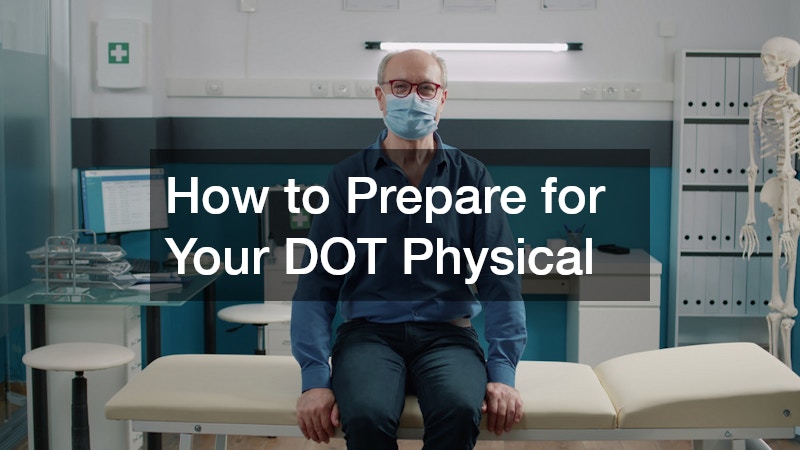How to Prepare for Your DOT Physical
For commercial drivers, maintaining good health is more than just a personal choice—it’s a professional requirement. A Department of Transportation (DOT) physical is a mandatory examination designed to ensure drivers are physically and mentally fit to operate commercial vehicles safely. This examination assesses critical health indicators such as vision, hearing, blood pressure, and overall physical condition. Preparing for a DOT physical is essential because it can impact your ability to drive, your career stability, and your livelihood. Understanding the process and taking steps in advance can help reduce stress and increase your chances of passing without delays or complications.
Preparation for this type of exam goes beyond simply showing up on the day of the appointment. Commercial drivers benefit from knowing what will be checked, organizing necessary paperwork, and managing their health well before the examination. By following a proactive approach—focusing on wellness, documentation, and understanding the testing process—you can help ensure a smooth experience and meet all the requirements without surprises.
Understanding the Purpose of a DOT Physical
The DOT physical safeguards drivers and the public by ensuring that individuals behind the wheel of commercial vehicles are healthy enough to perform their duties. It’s not designed to exclude qualified drivers but rather to identify medical conditions that could impair safe driving. The examination follows federal guidelines that standardize the process across the industry, giving every driver a clear set of expectations. By understanding its purpose, drivers can confidently approach the exam knowing it supports safety and well-being.
The DOT physical ensures compliance with Federal Motor Carrier Safety Administration (FMCSA) regulations. This includes evaluations of cardiovascular health, neurological function, musculoskeletal fitness, and the absence of conditions like uncontrolled diabetes or severe sleep apnea that could impair driving. Knowing this, drivers can plan by managing chronic health issues, controlling medical conditions, and communicating openly with the medical examiner about their history and current treatments.
Gathering Required Documentation and Medical History
Having the correct paperwork ready is one of the easiest ways to make the DOT physical process smoother. Medical examiners require certain documents to verify a driver’s health status and treatment history. Standard items include a valid driver’s license, a complete list of medications, and relevant medical records. Providing accurate information ensures that the medical examiner has a clear picture of your health and can make an informed decision about your certification.
For example, if you have a history of heart problems, recent test results and clearance letters from your cardiologist can save time and prevent delays. Drivers with conditions such as diabetes should bring documentation of their treatment regimen, blood sugar logs, and recent lab results. Those who use corrective lenses or hearing aids should bring them to the exam. Gathering and organizing all necessary documentation before the appointment can prevent repeat visits and streamline the entire process.
Managing Health and Wellness Before the Exam
Maintaining good health year-round is the best way to prepare for a DOT physical. Healthy eating habits, regular exercise, and sufficient rest contribute to meeting the physical requirements. Drivers prioritizing their well-being are less likely to encounter issues with blood pressure, weight, and energy levels during the exam. Lifestyle adjustments made in advance can also reduce the risk of failing due to controllable health factors.
Specifically, drivers can prepare by reducing sodium intake to help lower blood pressure, limiting caffeine before the exam to avoid elevated readings, and staying hydrated to ensure accurate urinalysis results. Regular physical activity, such as walking, stretching, and strength exercises, can improve endurance and mobility—both important for passing the exam. Managing chronic conditions like hypertension or diabetes through consistent medication use and follow-up appointments is equally essential for a smooth approval process.
Knowing What to Expect During the Appointment
Understanding the structure of the DOT physical can help reduce anxiety and ensure a more relaxed experience. Typically, the appointment begins with reviewing your medical history and discussing any current health concerns. The examiner then performs a series of physical checks to measure your vision, hearing, blood pressure, and heart rate, followed by a urinalysis to screen for underlying health issues.
The process is straightforward and usually takes less than an hour. Vision tests verify that you meet the required visual acuity with or without corrective lenses, while hearing tests ensure that you can perceive essential sounds on the road. Blood pressure and heart rate readings assess cardiovascular health, and the urinalysis checks for conditions like diabetes or kidney problems. By knowing what to expect, you can arrive prepared and confident, making the process more efficient and less stressful.
Following Up After Receiving Your Results
The conclusion of a DOT physical doesn’t necessarily mean the end of the process. If you pass, you’ll receive a medical certificate typically valid for up to two years, depending on your health status. If the examiner identifies a health concern, you may receive a shorter certification period or be required to undergo additional testing or treatment before recertification. Following up on recommendations promptly can help prevent interruptions in your driving career.
A DOT physical is more than just a legal requirement—it’s an opportunity to confirm that you’re healthy enough to handle the physical and mental demands of commercial driving. Preparing thoroughly by understanding the exam’s purpose, organizing documentation, focusing on your health, and knowing the steps involved can make the process straightforward and stress-free. Taking the time to address potential issues before your appointment can protect both your career and the safety of those around you.


